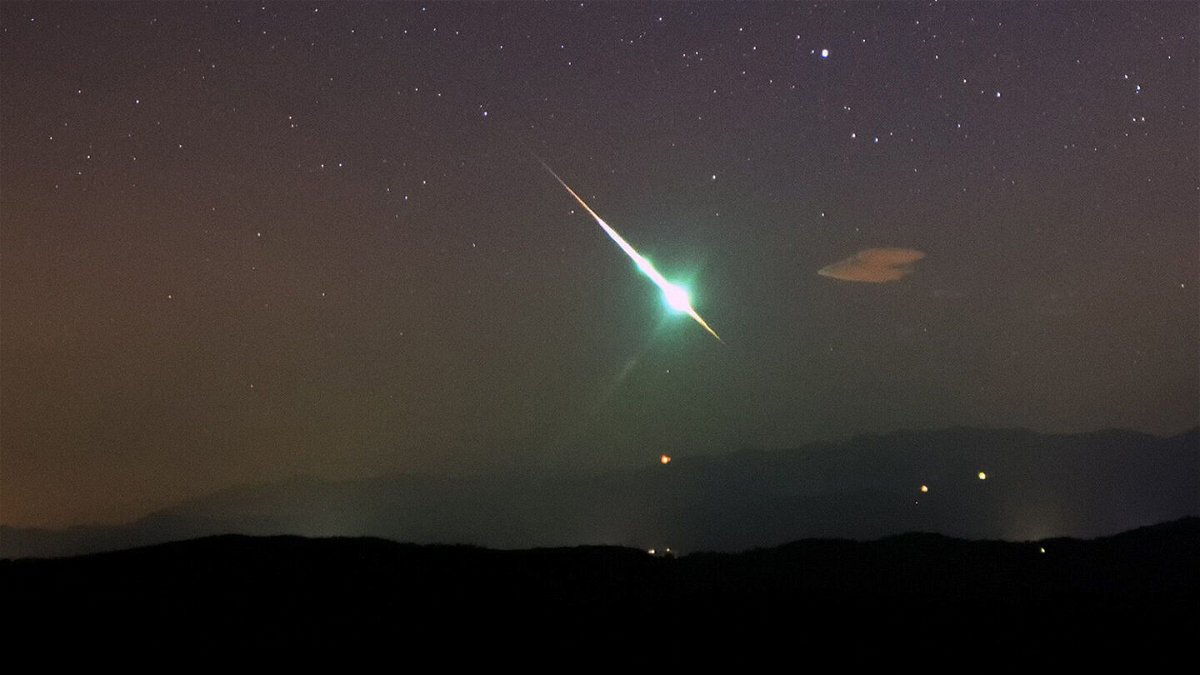This month’s Southern Taurids meteor shower will feature bright fireballs in the sky

A bright fireball is seen above Brkini
By Taylor Nicioli, CNN
Never mind that Halloween is over, because “Halloween fireballs,” as NASA calls them, can still be seen blazing bright in the night sky over the next few weeks, thanks to the Southern Taurids meteor shower.
The shower’s estimated peak isn’t until Saturday, November 5, according to EarthSky, and the Taurids are famous for producing the most and brightest fireballs — meteors that can appear brighter than the planet Venus.
This year’s shower is expected to include an increased number of fireballs, otherwise known as a Taurid Swarm. The Southern Taurids usually only feature around five meteors an hour surrounding its peak, the point where Earth is closest to the center of the stream of debris. But every seven years, Jupiter’s gravity pulls on the meteor stream and causes a spike in their numbers.
“With the normal rate for fireballs, someone would have to sit outside for 20 hours straight to see one,” said Robert Lunsford, fireball report coordinator for the American Meteor Society. “With the Taurids, (that time) can be reduced quite a bit, maybe down to five hours. And if you’re really lucky, you could just step outside and within a few minutes see one. When they appear is totally unpredictable.”
Origin of the Taurids
The Taurids are the result of a breakup of a very large comet around 20,000 years ago. Among other debris, that breakup created Comet Encke, which has an orbit around the sun of a little more than three years, the shortest of any major comet in our solar system. With every pass of Earth in its short orbit, it leaves a trail of debris behind. This trail includes the Southern Taurids, which are a cluster so large it takes our planet several weeks to pass through.
“Most meteor showers contain tiny bits of dust. Well, the Taurids … also has some large particles,” said Bill Cooke, NASA Meteoroid Environment Office lead. “And you’ll see, while the shower is active, not dust particles, but pebble-sized particles — and some (that) are football-sized and larger, which of course, produce brilliant, brilliant fireballs.”
Seeing a fireball
Fireballs from the Taurids are meteors larger than a meter across, and they shine exceptionally bright, according to NASA. They move slow because they strike the Earth’s atmosphere at a perpendicular angle, so they can be seen moving across the sky for a few seconds, versus the millisecond of visibility most meteors yield. The brighter and longer-lasting meteors can be seen fragmenting and falling apart as they travel through the sky, according to Lunsford. Oftentimes, the fireballs are colorful, appearing red, orange or yellow.
“It would be like a shooting star,” said Mike Hankey, the American Meteor Society’s operations manager and creator of its fireball tracking program. “But instead of lasting a half of a second, it might last for three or four seconds, and instead of just being as bright as a star, it might be as bright as the moon — sometimes even brighter.”
This year the meteor society has already recorded an above-average increase in fireballs, while NASA has photographed fireballs that appear to be even brighter than the moon in the night sky.
The best time to go out and spot a fireball will be at 2 a.m. local time throughout the next week, according to Lunsford. As the moon approaches its full moon stage set for November 8, its brightness will start to disrupt the chances of fainter meteors being seen, but fireballs, due to their size and brightness, can be seen anywhere in the world, at any time during the night.
Other space events this year
There are four more meteor showers you can see in the remainder of 2022, according to EarthSky’s 2022 meteor shower guide:
• November 12: North Taurids
• November 18: Leonids
• December 14: Geminids
• December 22: Ursids
And there are two more full moons on The Old Farmer’s Almanac 2022 calendar:
• November 8: Beaver moon (which will peak alongside a total lunar eclipse)
• December 7: Cold moon
The-CNN-Wire
™ & © 2022 Cable News Network, Inc., a Warner Bros. Discovery Company. All rights reserved.